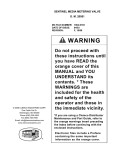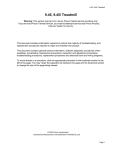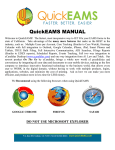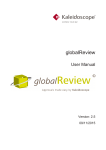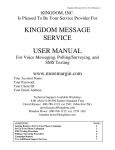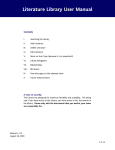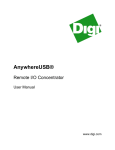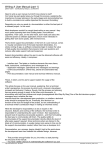Download Industrial Manufacturing Translation Services
Transcript
Translation Bulletin #102A Industrial/Manufacturing How to leverage translations to save time and reduce cost Translation memory: the key to efficiency and accuracy Whether you’re writing an operator’s manual or a sales brochure, you must write clearly and accurately, using a combination of industry terms and clear syntax. The same holds true for the professional translator who translates your document. A professionally trained, experienced translator brings industry-specific knowledge and language expertise to the task while also relying on translation tools for accuracy and efficiency. In fact, there is just as much art and science involved in translating a document as there is in writing it in English. You can play an active role in the translation process—and have peace of mind that your document is as accurate as the source original—by understanding some of the art and science of translation. One “tool” that professional translation services providers rely on is translation memory. Translation memory speeds the translation process, improves accuracy and aids consistency between projects. Knowing a few basics about how translation memory works will help you make the most of this technology. What is translation memory? Translation memory is a database. This database stores words, phrases, statements or complete paragraphs that are repeated throughout a document. The translation memory stores the source text and its corresponding translation in language pairs called “translation units.” Depending on the document, recurring phrases can make up as much as 40 percent of a document’s content. In addition to finding exact matches, translation memory also finds “fuzzy matches” that a translator can review and change. The more phrases that can be matched, the faster the entire piece can be translated while ensuring its consistency and improving its accuracy. www.ilstranslations.com • (952) 934-5678 While translation memory is useful within documents, it is also useful across documents. Boilerplate paragraphs, standardized text and disclaimers used in product literature, for example, need only be translated once per language and stored in the database. This avoids having to translate 100 percent of a document on subsequent projects. Translation memory reduces cost because the translator can work through a document efficiently. Repeated phrases aren’t retranslated with every occurrence. They are simply reviewed in each context for correctness. How you can leverage translation memory Although the concept of translation memory sounds straightforward enough, the complexity lies in how well translation memory is used and maintained. Translation memory is like a closet; in a well-organized closet, you can find what you need. And we all know how useful an unorganized closet is. You can help reduce translation cost and time by knowing a few simple tricks that help to organize your translation memory “closet.” These tactics include: creating a glossary of terms and a style guide, writing for consistency and working as a team with your translation provider. How translation memory works As a simple example, the sentence “The car is blue” is translated into Spanish as “El coche es azul.” If the sentence, “The car is red,” is also in the document, translation memory will identify the sentence as a partial match. The repeated sentence fragment, “The car is…” is stored in the database and doesn’t require translation. The translator would simply insert the word for “red” into the sentence: “El coche es rojo.” Translation Bulletin #102A Create a glossary Each industry or market has terms specific to its products, technologies and services. When you send a document out for translation, include a glossary of technical terms used in your document. Your translator will translate these terms and add them to the translation memory database. As the translator works through your document, translation memory will identify the terms as a “match,” allowing the translator to work through the document more quickly. The glossary has the added benefit of helping you write consistently. Some terms in English can be used interchangeably. For translation, only one word should be used throughout the document. This glossary can also include standarduse and style guidelines in English. Many industries abbreviate commonly understood terms and use acronyms that are understood in English, but may not easily translate into a different language. It’s best to have abbreviations and acronyms spelled out in a style guide so translation memory can make a consistent match and build an accurate database. In-country salespeople or other company experts are an ideal source for helping to develop industry-specific glossaries. They know the industry terminology in their native language and can provide their preferred verbiage. Your translator is a subject expert as well, but salespeople can Translation memory is not machine translation The big difference between translation memory and machine translation is the human element. Translation memory is an aid to translation controlled by human translators. On the other hand, machine translation, such as online tools offered by Google and Yahoo, is done entirely by a computer. Translation memory aids a professional translator by identifying phrases repeated throughout a document so the phrases only have to be translated once. The translator controls the process and understands the context, ensuring accuracy and consistency. Machine translation translates an entire phrase, sentence or document. It is unable to pick up the nuances of language and other ambiguities that a professional translator recognizes. Machine translation can’t identify certain contexts, i.e., the difference between “wood” and “lumber” or verb usage such as “raise children” or “raise corn.” To test how well machine translation works, translate a page of your website into Chinese and then translate it back into English. The results will give a good indication of the accuracy of machine translation. Machine translation is adequate for when you need the gist of an idea or phrase. When you need absolute accuracy and perfect syntax—and especially when you have legal responsibility for a document’s accuracy—contact a professional translation services provider. provide firsthand knowledge of your specific needs. Asking in-country salespeople to review a glossary is a better solution than asking them to review an entire translated document. Salespeople may not have the time or expertise, but they’ll take on the project to accommodate the request. The salesperson may decide to edit the document, and the meaning may change from the original source document. Or, he or she may decide that some parts of the document aren’t needed and simply delete them. The best contribution your in-country salesperson can make is to help develop a glossary of terms. Write for consistency The English language is full of synonyms. Synonyms can make an English document read in a more interesting way, but they can be an obstacle to efficient and accurate translation. For example, the safety section in a user manual might use the words “caution” and “warning” interchangeably. For translation, choose one of the words and use it consistently throughout the document. The translation memory software will pick up the one word, match it with the appropriate foreign language term and use it consistently throughout. This not only improves the consistency of your document, it simplifies translation. Only one word is translated and stored instead of two that have basically the same meaning. www.ilstranslations.com Translation Bulletin #102A Tips for translating your industrial/manufacturing document Whether you’re preparing a user interface, PowerPoint presentation, technical manuals, decals, warning labels, sell sheets or web sites, follow these tips for effective translation: • Know your audience – A product brochure may use less technical language than an operator’s manual. Your translator may use separate databases depending on the audience and degree of technicality of your document. • Write for consistency – The words “button,” “toggle,” “switch” and “knob” all have essentially the same meaning in English, but can pose translation challenges. Choose one word that best describes your apparatus and use it consistently throughout the English version. It will be accurately translated throughout your document. • Avoid excessive use of the product or model name – Instead of starting each sentence with, “Model XYZ will provide years of service if used properly,” use your company’s name. For example: “XYZ Corp. products will provide years of service if used properly.” That way the translation memory has one sentence that can be used across a product line, not a new translation memory entry for each individual product. Or, it’s possible that different people worked on the same manual and used different words for essentially the same object. For example, if your user manual uses the words “screen,” “monitor” and “display” interchangeably throughout the document, pick one of these terms and use it consistently. Translation memory will match this word with the appropriate translated term and use it throughout the document. translators or work with a new one for each project, this continuity will be lost. Translation service providers usually assign the same translation team to a client and the translators become familiar with unique style and requirements across projects. Work as a team Another way to ensure consistency is to work as a team with your translation services provider. Translation is a process that can be leveraged across many projects and many languages. Your translation memory database expands with every project you translate. The same terms will be applied whether you’re translating a website, a user manual or new product brochure. If you use multiple Effective as it is, translation memory doesn’t apply equally across every type of document. This database is more effective for technical translations than marketing materials. That’s because technical manuals use fewer descriptive phrases. Marketing brochures are written to describe why a product or service is new and improved, so the language in the brochure will be fresh as well. Still, you can leverage content in marketing brochures. Company descriptions, product tables, terminology and definitions won’t change, and that content can be leveraged across updated versions. www.ilstranslations.com 5810 Baker Road, Suite 250 Email: [email protected] Minnetonka, MN 55345 (952) 934-5678 Fax: (952 ) 934-4543 Conclusion Language translation is truly both an art and a science. Translation memory can provide the science by identifying terms, phrases and sentences that occur repeatedly throughout a document. This increases translation efficiency, saving time and money. The “art” of translation is provided by your translation team—the human element that can distinguish phrases and nuances of meaning and translate your document so that it communicates as accurately as the source original.



